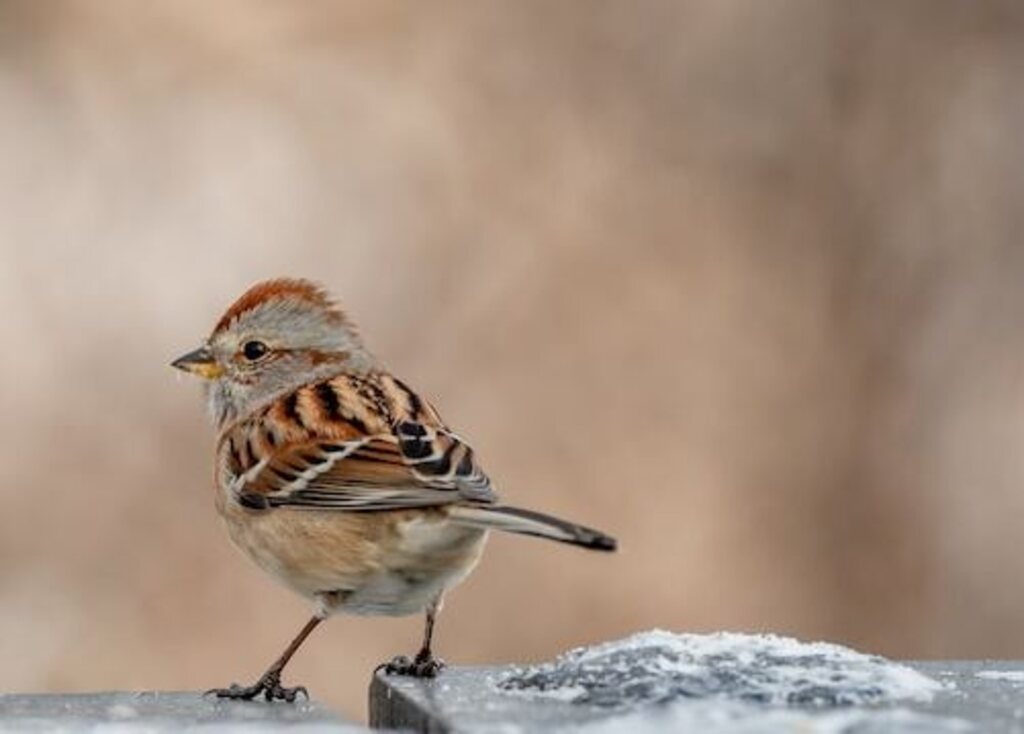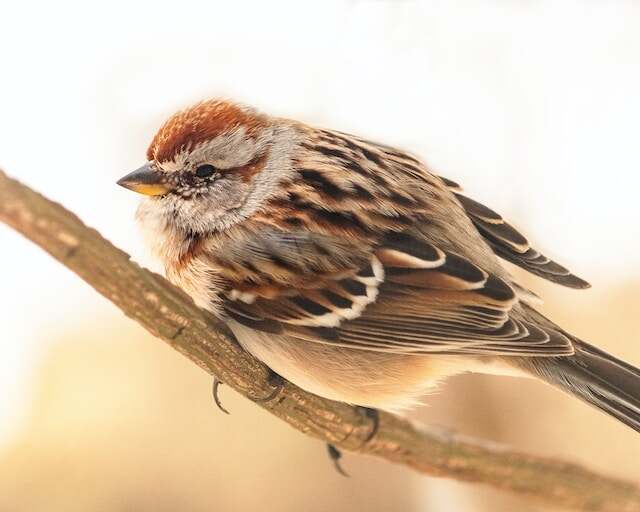Have you ever spotted a tiny bird with a rust-colored cap and a black spot on its chest? Chances are, you have encountered an American Tree Sparrow – a small but fascinating bird species that inhabits the woodlands and shrublands of North America.
In this article, we will delve into the world of American Tree Sparrows, exploring their habitat, behavior, diet, breeding patterns, migration, conservation status, range and distribution, and physical characteristics. Through our journey, we will unravel some interesting facts and insights about this remarkable bird species.
Table of Contents
- 1 Key Takeaways:
- 2 American Tree Sparrow Facts in the Wild
- 3 Key Identification Traits of American Tree Sparrows
- 4 American Tree Sparrow Habitat
- 5 Behavior of American Tree Sparrows
- 6 Diet of American Tree Sparrows
- 7 Breeding Patterns of American Tree Sparrows
- 8 Migration of American Tree Sparrows
- 9 Conservation Status of American Tree Sparrows
- 10 Range and Distribution of American Tree Sparrows
- 11 American Tree Sparrow Characteristics
- 12 Conclusion
- 13 FAQs: American Tree Sparrow Facts
- 13.1 What is the natural habitat of American Tree Sparrows?
- 13.2 What are some interesting behaviors exhibited by American Tree Sparrows?
- 13.3 What do American Tree Sparrows eat?
- 13.4 How do American Tree Sparrows breed?
- 13.5 Where do American Tree Sparrows migrate?
- 13.6 What is the conservation status of American Tree Sparrows?
- 13.7 Where can American Tree Sparrows be found in North America?
- 13.8 What are the characteristics that distinguish American Tree Sparrows?
- 14 Author
Key Takeaways:
- American Tree Sparrows are small birds with a rust-colored cap and a black spot on their chest.
- They inhabit the woodlands and shrublands of North America.
- They exhibit fascinating behavior, such as foraging habits, courtship rituals, and unique adaptations.
- Their diet primarily consists of seeds, berries, and insects.
- They migrate long distances and winter in the southern United States and Mexico.
- Their conservation status is of least concern, but some threats include habitat loss and climate change.
- They are known for their sweet and high-pitched whistle-like vocalizations.
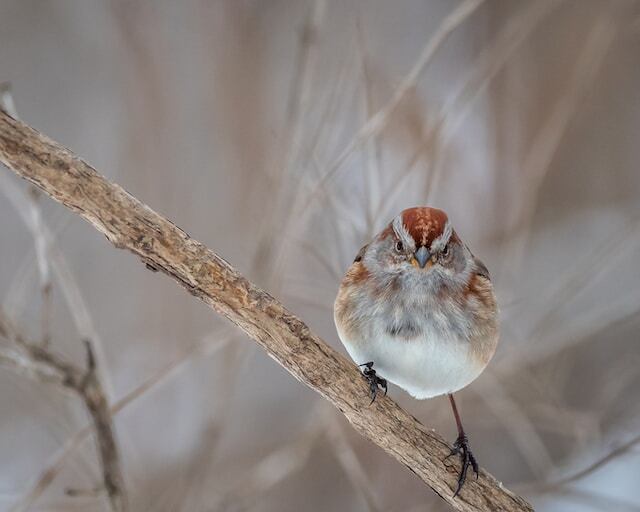
American Tree Sparrow Facts in the Wild
American tree sparrows are small birds that are native to North America. They are known for their distinctive markings, which include a rusty cap and a dark spot on their breast. These birds are found in a variety of habitats, including open fields, brushy areas, and forest edges.
American tree sparrows are primarily seed-eaters, but they will also feed on insects during the summer months. They are social birds and often form flocks during the winter months.
These birds are also known for their sweet, clear whistle, which can often be heard during the breeding season. Overall, American tree sparrows are fascinating birds that are well worth observing in the wild.
Key Identification Traits of American Tree Sparrows
| Characteristic | Description |
|---|---|
| Size | Small sparrow, approximately 5.5 – 6.3 inches (14 – 16 cm) |
| Weight | 0.6 – 1.0 ounces (18 – 29 grams) |
| Wingspan | 7.9 – 9.1 inches (20 – 23 cm) |
| Coloration | Brown back with streaks, white belly with dark spot |
| Crown and Face | Rusty cap and eyeline |
| Habitat | Northern forests, shrubby areas, brushy fields |
| Migratory Behavior | Long-distance migrator, breeds in North America |
| Feeding Habits | Seeds, insects, berries |
| Vocalization | Musical song with trills and whistles |
| Breeding Behavior | Nests on or near the ground, well-hidden |
| Range | Breeds in Canada, Alaska; winters in northern US |
| Conservation Status | Not threatened, stable population |
| Importance in Ecosystems | Seed dispersal, insect control |
American Tree Sparrow Habitat
The American Tree Sparrow (Spizelloides arborea) is a small passerine bird that inhabits a wide range of habitats across North America. These habitats may vary from boreal forests, shrubby areas, and open woodland to weedy fields and marshes, among others.
During the breeding season, American Tree Sparrows prefer to nest in areas with dense shrubs or thickets and conifers. They also inhabit boreal and tundra regions that have a few trees, such as the taiga and the edge of forests.
During winter months, they move to fields and other open areas with shrubs and bushes, such as hedgerows and field margins.
The American Tree Sparrow has a widespread breeding range that stretches from Alaska and across most of Canada. In the United States, it breeds in northern states, such as Maine, Minnesota, North Dakota, Michigan, and Montana.
During winter, it migrates to the northern United States and southern Canada, including the Great Lakes and New England regions.
Habitat Requirements
The American Tree Sparrow has specific habitat requirements, which include dense cover for nesting, good sources of food, and perches to scan the surrounding areas for potential predators. They also require water sources to drink and bathe.
During the breeding season, the American Tree Sparrow nests close to the ground, usually in shrubs or conifers. They also require substrates such as moss, grass, and leaves for their nests.
American Tree Sparrows feed primarily on seeds and insects. They consume a variety of seeds, including those of grasses, sedges, birch, alder, and others. During the winter season, they supplement their diet with buds, fruit, and insect larvae.
In conclusion, the American Tree Sparrow is a remarkable bird that inhabits a wide range of habitats across North America. Understanding their habitat requirements is essential to their conservation and survival.
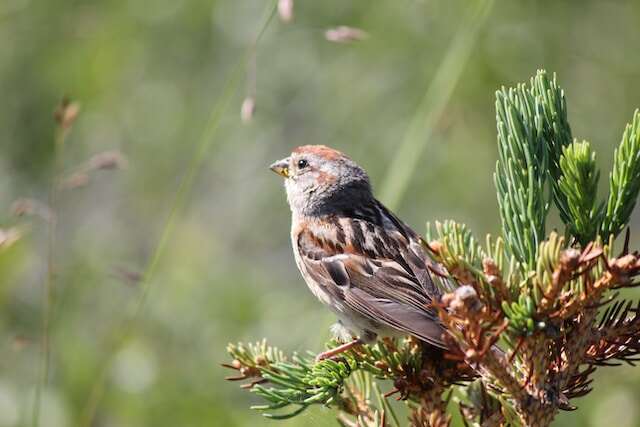
Behavior of American Tree Sparrows
American Tree Sparrows are fascinating birds with unique behaviors that distinguish them from other species. Their foraging habits, social interactions, and physical adaptations make them one of the most interesting birds to observe in the wild.
Foraging Habits
American Tree Sparrows primarily feed on seeds, but they also consume berries and insects. During the winter months, they will forage on the ground, searching for seeds and insects hidden beneath the snow. In the spring and summer, their diet changes to include more insects, which are an important source of protein for their growing offspring.
These birds are also known to use their feet to scratch through the snow to reach their food, a behavior not commonly seen in other bird species. This unique adaptation allows them to access food sources that may be inaccessible to other birds during colder months.
Social Interactions
American Tree Sparrows are social birds that form flocks during the winter months. These flocks can include other species of sparrows and birds, creating a diverse and dynamic group. Within the flock, communication is essential, and these birds use a variety of vocalizations to express their needs and intentions.
During the breeding season, American Tree Sparrows become more territorial and aggressive, fiercely defending their nesting sites from other sparrows. Males will often engage in courtship displays to attract females, including singing and fluffing up their feathers to appear larger and more attractive.
Unique Adaptations
American Tree Sparrows have several unique physiological adaptations that allow them to survive in their harsh northern habitat. They have thick layers of feathers and a layer of down to insulate them against the cold, and their feet have an increased blood flow that helps them regulate their body temperature.
Additionally, American Tree Sparrows have been found to have a smaller wing size relative to their body size compared to other bird species, which may allow them to conserve energy during long migrations.
Overall, the behavior of American Tree Sparrows is fascinating and unique, providing insight into the ways in which birds adapt to their environment and interact with each other.
Diet of American Tree Sparrows
American Tree Sparrows are primarily seed-eaters, feeding on a variety of small seeds throughout the year. During the breeding season, they also supplement their diet with insects and other small invertebrates. In the winter, when their preferred food sources are scarce, they may also eat fruits and berries.
The American Tree Sparrow’s diet varies depending on the time of year. In the summer, they predominantly feed on insects, while in the winter, they rely heavily on seeds. They have been known to visit bird feeders during the winter months, especially in urban areas where food sources are limited.
Their seed preferences include those of grasses, weeds, and garden plants, such as thistle, ragweed, and sunflower. American Tree Sparrows also feed on the seeds of birch, alder, and spruce trees.
These birds have a unique way of foraging for food, which involves scratching at the ground with both feet while perched on a plant or the ground. They then use their beaks to pick up the seeds or insects they uncover.
American Tree Sparrows also have a specialized digestive system that allows them to extract nutrients from seeds that other birds cannot digest.
Winter Diet
During the winter months, when food sources are scarce, American Tree Sparrows rely heavily on seeds. They primarily eat the seeds of grasses and weeds, such as goldenrod, ragweed, and wild rose. They have also been known to eat seeds found in commercial bird feeders, especially if they are filled with sunflower or thistle seeds.
One interesting fact about American Tree Sparrows is that they can survive for long periods of time without access to open water. They are able to obtain enough moisture from their food and from the snow that they eat.
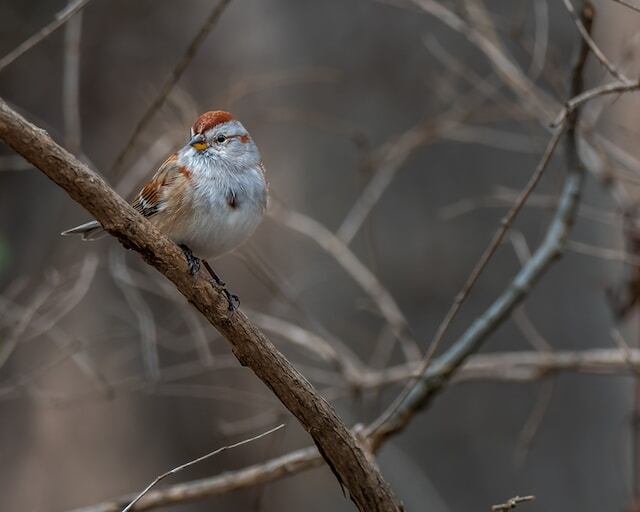
Breeding Patterns of American Tree Sparrows
American Tree Sparrows typically breed in the northern regions of Canada and Alaska, where they build their nests close to the ground in shrubs or low trees.
During breeding season, males will establish territories and begin performing courtship displays to attract a female mate. These displays may include singing, fluffing feathers, and hopping on the ground with wings outstretched.
Once a pair has formed, the female will take on most of the responsibility for building the nest and incubating the eggs. American Tree Sparrows typically lay 4-5 eggs per clutch, and both parents will contribute to feeding and caring for the young.
The incubation period lasts around 12 days, and the young will leave the nest after about 12-14 days. American Tree Sparrows may have up to two broods per breeding season.
Interestingly, American Tree Sparrows may form monogamous pairs or engage in polygyny, where one male will mate with multiple females. This behavior is more commonly observed in populations that have a higher male to female ratio.
The Incubation Process
During the incubation period, the female spends much of her time on the nest, with only brief breaks to feed or stretch her wings. The male will often bring food to her while she is on the nest.
Once the eggs have hatched, both parents will help feed the young by bringing back insects, seeds, and berries. In addition to feeding, the parents will also keep the nest clean by removing waste and any dead hatchlings.
Migration of American Tree Sparrows
American Tree Sparrows are highly migratory birds, spending their summer breeding season in the northern parts of North America and migrating southward for the winter. These small birds embark on long-distance journeys, covering thousands of miles each year to reach their wintering grounds. Their migration is triggered by changes in daylight hours and temperature, which signal the onset of winter.
During their migration, American Tree Sparrows traverse over land and water, flying solo or in small flocks. They follow well-established migration routes, known as flyways, which vary depending on their breeding location. Most American Tree Sparrows travel along the Atlantic Flyway, which stretches from eastern Canada to the southern United States. However, some populations follow the Mississippi Flyway or the Western Flyway, depending on their breeding range.
Interestingly, American Tree Sparrows show flexibility in their migration patterns, making adjustments based on weather conditions and food availability. For instance, they may delay their departure or change their flight path if there are severe storms or unfavorable winds. Additionally, they may alter their wintering location if food resources are scarce or abundant.
The wintering grounds of American Tree Sparrows are primarily located in the northern parts of the United States and southern Canada, with some populations venturing as far south as the central United States. They favor habitats such as open woodlands, hedgerows, and fields with shrubby vegetation, where they can find food and shelter.
Overall, the migration of American Tree Sparrows is a remarkable feat of endurance and adaptation, as these small birds navigate tough environmental conditions and make strategic decisions to ensure their survival.

Conservation Status of American Tree Sparrows
American Tree Sparrows have a relatively stable population and are not currently considered globally threatened. However, their range has been decreasing in some areas due to habitat loss and fragmentation caused by human activities such as agriculture and urbanization.
The American Bird Conservancy has classified American Tree Sparrows as a species of high conservation concern, and they are included in Partners in Flight’s conservation prioritization list. Additionally, the North American Bird Conservation Initiative has identified them as a priority species for conservation action.
Conservation efforts for American Tree Sparrows include habitat management and protection, restoration of degraded habitats, and monitoring of populations. Providing winter food sources such as seeds and suet can also help support their populations during harsh winter conditions.
| Threats to American Tree Sparrows | Conservation Strategies |
|---|---|
| Loss of breeding habitat due to agriculture and urbanization | Habitat management and protection, restoration of degraded habitats |
| Climate change affecting their wintering grounds | Monitoring populations and research on adaptation strategies |
| Collisions with buildings and communication towers | Implementing bird-safe building designs and lighting practices |
| Predation by free-roaming domestic cats | Promoting responsible pet ownership and keeping cats indoors |
Overall, continued conservation efforts are crucial for the long-term survival of American Tree Sparrows and other bird species.
Range and Distribution of American Tree Sparrows
American Tree Sparrows are a commonly sighted bird species across North America, known for their distinct appearance and winter migration patterns. They are found in the northernmost regions of North America, including parts of Alaska, Canada, and the northern United States. During the winter months, their range extends further south, with sightings reported in the central and eastern United States.
These birds tend to dwell in open spaces, favoring low-lying areas such as meadows, marshes, and tundra habitats. They are known to nest among shrubs and trees in the summer, but during migration, they can be found in a wide range of habitats, including woodlands, fields, and suburban gardens.
The American Tree Sparrow is an active migratory bird, traveling long distances to reach its wintering grounds. During the colder months, they make their way to the southern and eastern regions of the United States, as well as parts of Mexico. They are known to form large flocks during migration, which can number in the thousands.
Overall, the American Tree Sparrow has a broad and diverse range across North America, and can be found in a variety of habitats throughout the year, making it a common and easily recognizable bird species.
American Tree Sparrow Characteristics
American Tree Sparrows, also known as Spizella arborea, are small songbirds that are commonly found throughout North America. They are easy to spot with their distinctive markings and unique vocalizations. Here are some physical and behavioral characteristics that distinguish American Tree Sparrows from other bird species.
Physical Characteristics
American Tree Sparrows are small birds that measure about 5 to 6 inches in length and weigh around 0.5 to 0.7 ounces. They have a round body, a short tail, and a cone-shaped beak that is perfect for cracking seeds. In terms of coloration, American Tree Sparrows have a rusty cap on their head, a gray face, a black spot on their chest, and brown wings with white bars.
They also have a distinctive rufous-colored stripe above their eyes that sets them apart from other sparrow species. Their plumage changes with the seasons, with brighter colors during the breeding season and duller colors during the winter months.
Behavioral Characteristics
American Tree Sparrows are social birds that are often seen in small flocks during the winter months. They are ground-foragers that primarily feed on seeds, but also eat berries and insects. During the breeding season, they become territorial and defend their nesting sites.
Male American Tree Sparrows perform elaborate songs to attract mates, which are typically sung from a high perch. They also have a unique adaptation called the “mourning cloak” that keeps their feet warm in cold temperatures. This adaptation is a patch of skin on their feet that is covered in scales and feathers.
Social Structure
American Tree Sparrows are migratory birds that breed in the northern regions of North America and winter in the southern regions. They are monogamous and form pair bonds during the breeding season. Females typically lay 3 to 5 eggs in a nest constructed of grass, twigs, and moss.
The eggs hatch after about 10 days and the young fledge after 9 to 12 days. During the winter months, American Tree Sparrows form flocks with other bird species, such as juncos and goldfinches, to forage for food and provide protection from predators.
Vocalizations
American Tree Sparrows have a unique song that is often described as a sweet, thin whistle. Their song is a series of musical notes that resemble the sound of “me-so-sweet.” They also have several calls that are used for communication, including a “tseep” call that is used to maintain contact with other birds in the flock.
Conclusion
In conclusion, American Tree Sparrows are fascinating creatures that offer a unique look into the natural world, from their preferred habitats and behaviors to their diet and breeding patterns. These resilient birds migrate long distances each year, showcasing their adaptability and endurance.
However, American Tree Sparrows face threats to their populations, including habitat loss and climate change. Conservation efforts are critical to preserving these valuable members of the ecosystem.
Overall, studying American Tree Sparrows offers insight into the complex interplay of species and the importance of conservation efforts to protect our delicate ecosystem.

FAQs: American Tree Sparrow Facts
What is the natural habitat of American Tree Sparrows?
American Tree Sparrows are typically found in open areas with shrubs and low vegetation, such as tundra, taiga, and brushy fields.
What are some interesting behaviors exhibited by American Tree Sparrows?
American Tree Sparrows engage in foraging behavior, social interactions with other sparrows, and have unique adaptations for surviving cold winters.
What do American Tree Sparrows eat?
American Tree Sparrows primarily feed on seeds, berries, and insects. Their diet may change depending on the availability of food throughout the year.
How do American Tree Sparrows breed?
American Tree Sparrows build nests on the ground, typically concealed in vegetation. They engage in courtship rituals and have an incubation period of about 12-14 days.
Where do American Tree Sparrows migrate?
American Tree Sparrows migrate long distances, with their wintering grounds primarily located in the southern parts of the United States and into Mexico.
What is the conservation status of American Tree Sparrows?
American Tree Sparrows are considered a species of least concern, but conservation efforts are important to monitor threats to their population and protect their habitats.
Where can American Tree Sparrows be found in North America?
American Tree Sparrows have a wide range across North America, with their summer breeding grounds in the northern parts and winter ranges extending into the southern regions.
What are the characteristics that distinguish American Tree Sparrows?
American Tree Sparrows have a distinct appearance with rusty caps, gray-brown bodies, and a small dark spot on their chest. They also have unique vocalizations and social structures.

